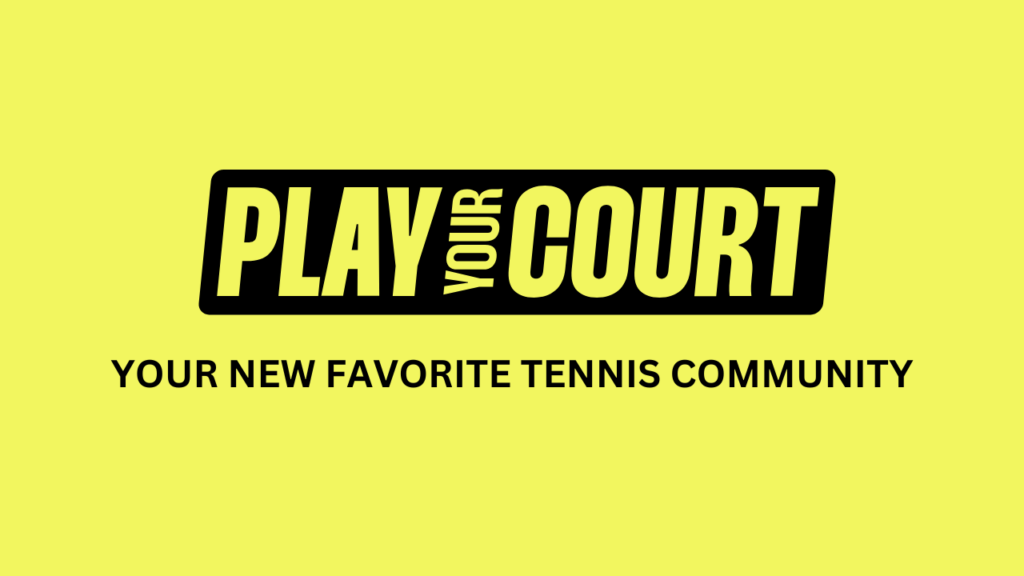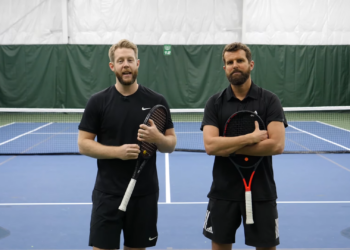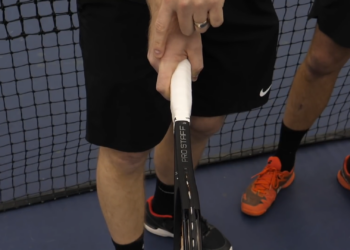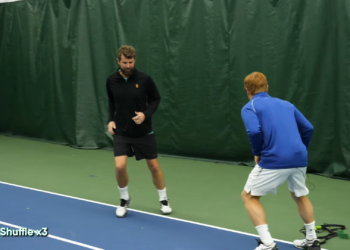You go through your serve motion, swing like you mean it, and still the ball floats forward, then dies in the net. It’s the most frustrating moment in tennis.
When your serve won’t clear the net, it can mess with your rhythm, your confidence, and let’s be real, your love for the game.
I’ve been there.
“I’m doing everything right, but the serve still won’t go in.”
You are usually not doing everything wrong… but you’re also not fixing the right things. That’s where this article comes in.
We’re going to walk through exactly why your serve keeps clipping the net, breaking down the mechanics, mindset, and bad habits that most players don’t even realize are sabotaging them.
From poor toss technique to the wrong grip to the mental freeze that happens when you step up to the line, we’ll cover it all.
Let’s clear the net and your doubts.
The Real Reason You’re Hitting the Net (Hint: It’s Not Just One Thing)
When players come to me saying, “I’m serving hard, I’m doing the drills… but the ball keeps landing in the net,” the problem is almost never just one thing.
It’s usually a cocktail of small breakdowns in toss, swing path, grip, contact point, and nerves, each one chipping away at your serve without you even realizing it.
Let’s unpack the biggest culprits and how to fix them.
1. Your Ball Toss Is Sabotaging You
Let’s get this out of the way: your toss matters more than your swing.
I’ve seen hundreds of technically solid serves fall apart because the toss was inconsistent, too low, or floating all over the place. If you’re tossing to the wrong spot, it doesn’t matter how strong your motion is, you’re set up to fail.
Toss Height Matters:
A toss that’s too high wrecks your timing and causes you to swing on the way down.
A toss that’s too low forces you to rush and hit with a bent arm, hello, net city.
Your ideal toss should peak just slightly above your fully extended racquet so you can swing up, not at, the ball.
Toss Location is Critical:
Right-handers, your golden contact zone is at 1 o’clock, just off your front foot. Not 12, not 2.
That spot gives you the ideal alignment to swing up, pronate, and hit with power and clearance.
Toss Anxiety Is Real:
I get it, you toss the ball, it floats sideways, and instead of letting it drop and starting over, you chase it and swing anyway.
Why? Because you don’t want to look indecisive or “annoy” your opponent.
But here’s the deal: swinging at a bad toss is self-sabotage.
Fix It at Home (Seriously):
We teach this inside PlayYourCourt all the time: place your racquet on the ground pointing to 1 o’clock. Practice tossing the ball so it lands consistently on the strings.
No court needed. Just you, the racket, and the rhythm.
2. You’re Probably Swinging Forward, Not Up
Let’s debunk a myth: nobody in the history of high-level tennis swings down on their serve.
Even when you’re hitting a flat bomb, the swing path is up through the ball, with a slight forward motion on contact.
The Physics Don’t Lie:
You’re serving from behind the baseline, 39 feet from the net. The only way the ball clears that barrier with margin is if you’re swinging upward at contact, not forward or, worse, down.
But My Coach Said Hit Down…
Then they’re coaching wrong. Seriously. Swinging down is a surefire way to bury the ball in the net. You need lift, pronation, and upward shoulder extension, not a chopping motion.
Fix It Fast:
One of my favorite drills is serving from your knees. It takes your legs out of the equation and forces you to swing up. You’ll quickly learn that downward swings don’t work when you can’t cheat forward.
3. Grip Check: Are You Holding It Like a Frying Pan?
If you’re still using your forehand grip on the serve… we need to talk.
Why Continental is Mandatory:
The Continental Grip gives you the angle and range to swing up, pronate, and generate spin and lift. Every pro uses it. Every consistent server uses it. There’s no way around it.
The Frying Pan Trap:
Holding your racquet like a spatula might feel “safe” but it robs you of pronation, leads to a straight-on hit, and often a dead, downward ball that catches the net.
Try This Check:
Hold your racquet loosely and simulate a serve. Can you naturally snap your wrist at contact and rotate the racquet face outward? If not, your grip is killing your serve.
4. Poor Contact Point Mechanics
You might be doing everything else right… and still miss because you’re striking the ball too low or too close to your body.
Your Ideal Contact Point:
Arm fully extended. Racquet reaching up and forward. Ball positioned just slightly ahead of your front shoulder. That’s your strike zone.
Learn from the Pros:
Look at Federer’s toss, it arcs just forward enough to encourage an upward, reaching motion. Kyrgios, despite his flair, maintains similar contact fundamentals. You can’t afford to skip this detail.
Breaking the “Revert Back” Cycle:
“I try to fix it, but I keep reverting back.” That’s normal. It’s your motor memory taking over. The solution? Reps and triggers. Start every serve practice with slow shadow motions that reinforce proper contact mechanics.
5. You’re Too Tight (Yes, Your Tossing Arm Too)
Nerves and tension don’t just live in your head, they show up in your body. Especially your tossing arm.
What Tension Does:
Stiff fingers? Erratic toss. Tight wrist? Inconsistent height. Clenched shoulder? Goodbye racquet speed. Muscle tension is the silent killer of good serves.
Pre-Toss Drill:
We use this with PYC students before every lesson: Hold the ball in your fingertips, lock your tossing elbow, and raise the ball gently in a straight line, no flicking. This drill alone fixes more tosses than most full lessons.
Visualize Your “Happy Toss Place”:
Before you serve, pause. Imagine your ball arcing perfectly to 1 o’clock. Smooth. Effortless. That visualization wires your brain for the motion you want instead of the mistake you fear.
Tennis is a feel sport, but feel doesn’t always lead you in the right direction.
Mechanics matter. And when it comes to clearing the net, these five fixes are where you start.
5 Advanced But Simple Drills to Stop Hitting the Net
So now that you know what’s going wrong with your serve, let’s fix it with drills that actually work.
These aren’t the same recycled tips you’ll find on a random YouTube rabbit hole, these are purpose-built exercises we use inside PlayYourCourt to rewire bad habits and lock in upward swing mechanics.
And the best part? Most of them don’t even require a court.
1. Curtain Drill for Upward Swing
If I could only teach one drill to help players feel what it means to swing up, this would be it.
Find a curtain, net, or soft barrier and stand about two feet away. With no ball, perform your service motion and intentionally trap your racquet into the curtain at full extension.
What you’re doing is grooving the correct contact angle, the racquet face should be square and rising at the moment it meets resistance. If your racquet face hits the curtain tilted down? You just diagnosed your net problem.
Do this ten times before every hitting session. It rewires the upward swing faster than anything else I’ve ever used.
2. Target Toss Drill (With a Racket as Your Bullseye)
Most players spend zero time practicing their toss. If you’re not grooving your toss, you’re guessing.
And guess what happens when you guess? You hit the net.
Here’s the fix:
Place your racquet flat on the ground with the handle aligned to your front toe and strings angled to your ideal contact point at 1 o’clock.
Now toss the ball 25 times.
How many land cleanly on the strings? That’s your toss accuracy score. Start with 5 out of 25 and work your way up to 20+. No racquet swing needed, just consistency, calm, and control.
Pro tip: Track your best streak and try to beat it every week. Your toss will stop sabotaging your serve.
3. Serve From Knees
This one’s a game-changer.
Kneel on the court (or grass) and go through your service motion with a light ball or even no ball at all.
When you’re on your knees, there’s no way to swing forward and still generate power or net clearance. The only option is a pure upward swing.
It’s humbling, awkward, and wildly effective. Within 10 reps, you’ll feel the exact muscles that need to fire and you’ll see the difference in trajectory once you stand back up.
We’ve had players unlock 6–8 inches of extra net clearance just from this drill alone.
Do it before every serve session and watch the ball start soaring over instead of diving into the net.
4. “Don’t Chase Toss” Challenge
You know the story. You toss the ball too far forward or sideways and instead of starting over, you panic-swing to avoid looking indecisive. And bam, serve into the net. Again.
You can legally retoss the ball as many times as you want, as long as you don’t hit it or make contact. Yet most players avoid doing this because they feel embarrassed.
Let’s fix that.
Try this challenge: Every time your toss is off, force yourself to let it drop, no matter how tempting it is to swing.
Count how many times in a row you commit to perfect toss discipline. Once you get to 10, your game changes. Because now you’re building a pro-level mindset, not just a better toss.
And if you’re worried about your opponent judging you? Trust me, they’re just glad you’re the one serving.
5. Visualization & Breathing Ritual
This isn’t fluff, it’s high-performance mindset training.
Before every serve, bounce the ball a few times (pick a number and stick to it).
Inhale through your nose, exhale through your mouth, and visualize the ball tossing to 1 o’clock, your racquet accelerating up, and the ball clearing the net with margin and spin.
Why does this work? Because it wires your nervous system to trust the motion instead of fearing the outcome.
Toss anxiety, swing hesitation, and serve yips don’t show up when your body is relaxed and your brain knows exactly what it’s trying to do.
It’s about mind-body alignment.
These five drills may look simple, but they’re loaded with technical corrections baked into real-world movement.
They’re used by PlayYourCourt coaches every day with students who, just like you, were stuck in the net, not because they lacked power, but because they lacked the right plan.
Why This Happens to Intermediate Players More Than Beginners
If you’re stuck at intermediate level and your serve still keeps crashing into the net, I want you to know something: you’re not broken.
In fact, this is the single most common frustration we hear from PlayYourCourt members at that intermediate level.
Here’s why this specific group struggles more than beginners:
The False Confidence Trap
At intermediate you’ve put in some reps. You know the rules, you’ve got rally skills, and maybe you’ve even started playing competitive matches.
But because you can “get the ball in” on groundstrokes, there’s often this rush to hit a bigger, flatter serve, before the foundational mechanics are dialed in.
Flat serves might look cool, but if your toss is off, your swing path is forward instead of up, or your grip isn’t Continental? That ball’s going straight into the net.
No topspin. No clearance. Just frustration.
It’s like building a house on sand. It might look okay for a while… until something collapses.
YouTube Misfires and the DIY Downward Spiral
Let me guess: you’ve spent hours watching random tennis videos online, trying to self-fix your serve.
Maybe one coach said “swing out,” another said “hit down,” and now your body’s caught between 14 conflicting cues.
I love free information as much as anyone. But when it comes to the serve, bad advice reinforces bad mechanics, especially if it’s not tailored to your body, timing, or technique. And unfortunately, most intermediate players end up hard-wiring those mistakes with repetition.
That’s why your serve feels “off” even when you’re practicing more. You’re not just repeating the wrong motion, you’re getting better at doing it wrong.
Don’t Plateau, Break Through
If you’re nodding along right now, it’s time to stop guessing and start progressing.
Our Serve Mastery series was built for this exact phase of the game. We walk you step-by-step through grip corrections, toss drills, swing path coaching, and mental resets, so you don’t just serve harder… you serve smarter.
👉 Join the Serve Mastery Series and stop spinning your wheels.
You don’t need to change everything. You just need to change the right things. Let us help you find them.
Mindset Matters: Why Fear and Pressure Make You Serve Worse
Let’s get brutally honest here, your mind might be wrecking your serve more than your mechanics ever could.
I’ve seen it too many times: a player hits solid serves in practice, but as soon as there’s pressure, a crowd, a score, a partner watching, their toss goes wild, their swing tightens, and the ball nosedives into the net.
It’s because their mental game collapsed at the worst possible time.
“I Hate Walking to the Line to Serve”
That fear doesn’t start at the baseline. It starts in your head. Then it travels to your body.
Here’s how it plays out:
- Nerves tighten your grip and your toss arm.
- Tight toss floats too low or off-angle.
- You swing anyway, desperate not to look unsure.
- Ball hits the net.
- You beat yourself up.
- Rinse and repeat.
That’s the internal pressure loop and it kills confidence faster than any technical flaw.
The fix? Shift from fear to flow.
Build a pre-serve routine that you repeat every single time, no matter the score.
A few deep breaths. Visualize the arc. Commit to your toss spot. Step up with purpose. When you control the routine, the nerves don’t control you.
“Why Does This Only Happen in Matches?”
It’s the question every frustrated player eventually asks, “Why is my serve fine in practice, but not in a match?”
Here’s why: practice serves are relaxed. No scoreboard. No judgment. No pressure.
But when the match starts? Your body gets flooded with adrenaline and your brain starts running worst-case scenarios.
That’s when bad tosses, rushed motions, and net faults show up like old high school rivals.
It’s not your technique breaking down, it’s your routine that didn’t hold under pressure.
That’s why we always say: practice your routine, not just your swing.
Every time you serve, practice, match, warm-up, it should look the same.
Same bounces. Same breath. Same toss visualization. You’re building a safety net your brain can trust when it counts.
Your serve doesn’t need more power. It needs more trust, in your process, your practice, and your ability to stay calm under fire. And trust, like a good toss, is something you build one rep at a time.
Your Serve Isn’t Broken, It’s Under-Coached

If your tennis serve keeps falling short, into the net, into doubt, into frustration, it’s because you’ve been under-coached. And more importantly, under-supported.
You don’t need to hit harder. You don’t need a $300 racquet.
You need better mechanics, a confident mindset, and real guidance tailored to your game.
That’s exactly what we built the new PlayYourCourt membership to deliver.
We’re not just a practice partner app anymore. We’ve evolved into a complete game improvement platform, designed to solve the specific problems holding you back.
Like your serve. Like your toss. Like your match confidence.
With on-demand video tips, guided Serve Challenges, technique breakdowns, and coaching from pros, you’ll finally get the clarity and tools to unlock your serve for good.
You’ll get matched with like-minded players, plugged into a community that’s pushing forward just like you, and supported by coaches who fix these issues every day.
🎾 Explore the PlayYourCourt Membership → Try 7 Days Free
This is your turning point. Let’s build a serve (and a game) you can trust.



